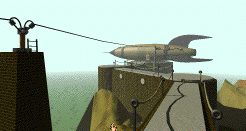I wish I were telling you about my experiences with Myst, the genuinely innovative and popular multimedia CD-ROM that carries you off to a magical island, and places beyond, to solve an ancient mystery. For many people, Myst has begun to make good on the promise of new digital technology to immerse you in worlds of the imagination. Broderbund, Myst's publisher, says that its "surrealistic adventure will become your world."
In fact, however, when I set out to make Myst's world mine, I wound up stranded in a different, though equally surrealistic, dimension. It is so unpleasant a locale that it appears to have no name of its own, but after a couple of weeks in its labyrinthine environs I decided to call it Nerdland. The place is familiar to people who have actually begun to experiment with multimedia in their homes, but it remains a well-kept secret from the rest of the population. Yet it is terrain that, sooner or later, anyone who pops a CD-ROM into a computer hoping for some fun is likely to cross.
How did I wind up in this accursed spot? I wanted to write about Myst, a product that -- like many multimedia projects -- was originally developed for Macintosh computers but had recently been issued in a format for Windows computers. Macs are known for ease of "configurability" -- their different components tend to talk the same language without any tweaking on your part. But Windows machines way outnumber them and, till recently, have tended to be less expensive. So when I invested in a home computer three years ago -- several eons in Nerdland reckoning -- I went for what was then a Windows hot-rod. (The details, in nerdspeak: 486 DX2-50, 8 MB RAM, ATI Mach 8 graphics acceleration, Pro Audio 16-bit sound card, double-speed CD-ROM drive.)
The trouble is, Myst is the kind of product that, as they say, pushes the envelope's edge -- and my machine's envelope was signed, sealed and delivered two computer-architecture generations ago. When I tried to install Myst, I started receiving strange, garbled messages on my screen: "Cannot Read From Drive D." "Error loading Resource 10." "Shadow Initialization Error."
I liked the Jungian sound of that. Something was amiss -- and I had to plunge into the digital darkness and set it right. Interestingly, Myst's own story, as those who have successfully installed it learn, begins with a garbled message from a prisoner whose speech fades in and out like a bad radio signal. I was beginning to see parallels between Myst's game-play and my own meta-Myst experience: Life was becoming Myst, though not as the game's designers intended.
Calls to Broderbund's helpful technical support line introduced me to the truly esoteric realm of device drivers, which I'd happily detoured around in the past. In Nerdland, drivers are little programs that let all the devices plugged into your computer -- disk drives and sound cards and monitors -- talk to each other. Mine had always gotten along fine, so I hadn't bothered much with warnings to update them regularly -- to obtain the latest versions from the equipment manufacturers or online services. Broderbund informed me, gravely, that every driver in my system needed to be updated.
I will spare you the saga of my device-driver hunt through the dark thickets of the Microsoft Download Service, the Media Vision Bulletin Bin Board and other forsaken places -- or the desperate expeditions into the clammy mines of my computer's configuration files required to install the precious things. Some tales are best left to the imagination.
I cockily returned to Myst's installation program -- but my swagger was premature. The game worked, but with a hobble. The soundtrack played only in choppy, two-second chunks. The introductory movie coughed out only a few random stills. Sometimes the computer froze up completely.
Aha, I thought; my hardware is just too antediluvian to do Myst justice. To put some zip back into things, I invested in a potent disk-caching program and a Mach 32 graphics accelerator, which I'd been eyeing for some time anyway. Now, I thought, I was ready to do combat with the beast.
How naive! As I write this, Myst is still not running reliably on my computer -- though I can sometimes coax it into sharing tantalizing glimpses of itself.
Kathleen Burke, the company's publicity director, sounded surprised when I told her my woes, and says that such problems are possible but not common: "We are pushing the limits of the technology. You just never know -- there are so many different configurations. Our quality assurance people tested almost every possible combination of sound card and video card and so forth to try to make sure that this sort of thing doesn't happen."
In truth, despite all my travails, Myst remains a good bet compared with so much of the overhyped multimedia junk out there. At least, if and when you do get it to work, it's worth the effort.
I haven't given up the quest -- but I do have a deadline to meet.
POSTSCRIPT Feb. 1995
The sad truth is that I never did get Myst to run properly on my PC. After some more fiddling, I gave up trying. I respond as knee-jerkily to a technical challenge as the next guy, but eventually, sanity kicks in.I received an avalanche of mail in response to this piece, most of which were variations on the message: "Get a Mac, dummy."
Eventually, I took the advice. And the Macintosh edition of Myst runs just fine on my Quadra 650.
I don't wish to enter into the fray of the Mac vs. PC religious wars. I merely report this glitch experience. Draw your own conclusions.
 Back to Multimedia Horror Stories
Back to Multimedia Horror Stories Back to Kludge's Front Page
Back to Kludge's Front Page
This page maintained by Scott Rosenberg (scottr@sirius.com).
All contents © copyright 1995 by Digital Media Zone.

